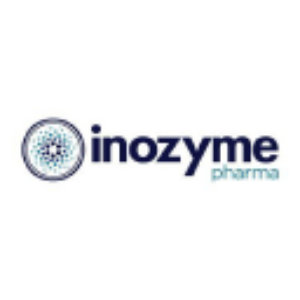Inozyme Pharma Reports Full Year 2023 Financial Results and Provides Business Highlights
– Topline data from ongoing Phase 1/2 trials of INZ-701 in adults with ABCC6 Deficiency and ENPP1 Deficiency expected in early April –
– Phase 1 trial of INZ-701 in end-stage kidney disease (ESKD) patients receiving hemodialysis (SEAPORT-1) now underway (NCT06283589), with topline data expected in Q4 2024 –
– Launched global patient registry (PROPEL) in partnership with GACI Global to advance understanding of ENPP1 Deficiency and infantile-onset ABCC6 Deficiency (NCT06302439) –
– Cash, cash equivalents, and short-term investments as of December 31, 2023 expected to fund operations into the fourth quarter of 2025 –
BOSTON, March 12, 2024 (GLOBE NEWSWIRE) -- Inozyme Pharma, Inc. (Nasdaq: INZY) (“the Company” or “Inozyme”), a clinical-stage rare disease biopharmaceutical company developing novel therapeutics for the treatment of pathologic mineralization and intimal proliferation, today reported financial results for the full year ended December 31, 2023, and provided recent business highlights.
“We believe we are well-positioned to continue to advance INZ-701 through several anticipated value-creating milestones in the year ahead,” said Douglas A. Treco, Ph.D., CEO of Inozyme Pharma. “Of note, we are on track to report topline data from our ongoing Phase 1/2 trials in adult patients with ABCC6 Deficiency and ENPP1 Deficiency in early April. Data from these trials along with learnings from our recently launched global patient registry in partnership with GACI Global have the potential to play a meaningful role in bringing INZ-701 closer to patients facing these challenging diseases.”
Dr. Treco added, “Beyond our two lead indications, today we are pleased to announce the initiation of our Phase 1 SEAPORT-1 trial in patients with end-stage kidney disease (ESKD) receiving hemodialysis, of which calciphylaxis is a severe complication. Calciphylaxis represents a devastating condition characterized by pathologic mineralization and intimal proliferation. Clinical data to date have demonstrated that INZ-701 was generally safe and well tolerated and meaningfully increased PPi levels in adults with ENPP1 and ABCC6 Deficiencies, conditions that share similar pathology to calciphylaxis, supporting the idea that INZ-701 could ultimately serve as a therapeutic option for this underserved population.”
Recent Updates and Anticipated Milestones
- Phase 1/2 Clinical Trials of INZ-701 in Adults with ABCC6 Deficiency (pseudoxanthoma elasticum or PXE) and ENPP1 Deficiency. The Company expects to report topline data from its ongoing Phase 1/2 trial of INZ-701 in adults with ABCC6 Deficiency and topline data from the first three cohorts of its ongoing Phase 1/2 trial in adults with ENPP1 Deficiency in early April.
- Global ENPP1 Deficiency and Infantile-Onset ABCC6 Deficiency Patient Registry (PROPEL NCT06302439). The Company announced the launch of a global patient registry in partnership with GACI Global, a patient advocacy group that connects families affected by generalized arterial calcification of infancy (GACI) or autosomal recessive hypophosphatemic rickets type 2 (ARHR2). The patient registry is designed to better characterize the natural history, disease course, long-term outcomes, and true disease burden in patients with ENPP1 Deficiency and infantile-onset ABCC6 Deficiency (GACI Type 2). The registry will assess three distinct cohorts:
- Patients of all ages with ENPP1 Deficiency with evidence of biallelic ENPP1 variants
- Patients with evidence of monoallelic ENPP1 variants and disease-related symptoms
- Patients under 18 years of age with infantile-onset ABCC6 Deficiency with monoallelic or biallelic ABCC6 variants
To date, the Company has identified over 1,000 patients globally with confirmed or suspected ENPP1 Deficiency and collected data on a number of symptomatic ENPP1 Deficiency patients with monoallelic ENPP1 mutations.
- Patients of all ages with ENPP1 Deficiency with evidence of biallelic ENPP1 variants
“At GACI Global, we are dedicated to furthering the understanding of these devastating diseases in order to advance the development of potential treatments,” said Christine O’Brien, co-president of GACI Global. “Our partnership with Inozyme has played an important role in that mission while ensuring the GACI community has a voice.”
- Phase 1 SEAPORT-1 Trial of INZ-701 in Patients with ESKD Receiving Hemodialysis Now Underway (NCT06283589). The Company today announced the initiation of its Phase 1 SEAPORT-1 trial of INZ-701 in patients with ESKD receiving hemodialysis, of which calciphylaxis is a severe complication. The trial is designed to assess safety, tolerability, pharmacokinetics (PK), and pharmacodynamics (PD) of INZ-701 in up to 10 patients with ESKD receiving hemodialysis. Patients will receive 1.8 mg/kg of INZ-701 once weekly, coinciding with their hemodialysis treatment, for a total of 30 days. The study’s primary endpoint will assess safety and change from baseline plasma PPi concentration, with secondary endpoints including PK and PD parameters. Topline data from the study are expected in the fourth quarter of 2024.
Inozyme previously presented data at the American Society of Nephrology (ASN) Kidney Week 2023 in October 2023 and at the European Calcified Tissue Society Congress (ECTS) in May 2022, which showed the following:
- Patients with ESKD had significantly lower PPi levels compared to healthy subjects
- Patients with patients with calciphylaxis had significantly lower PPi levels when compared with ESKD patients without calciphylaxis
- Low PPi levels were associated with morbidity and predicted 6-month mortality among ESKD patients with calciphylaxis
- Low PPi levels are correlated with higher numbers of skin lesions in calciphylaxis
“ESKD patients suffering from calciphylaxis face a poor quality of life and, unfortunately, a particularly dismal prognosis,” said Sagar Nigwekar, M.D., MMSc, Co-Director, Kidney Research Center, Massachusetts General Hospital. “I am hopeful that INZ-701 could serve as a much-needed treatment for this underserved patient population. I look forward to the data from this study, as well as more advanced clinical trials of INZ-701 in calciphylaxis.”
Anticipated Milestones
- ENPP1 Deficiency
- Topline data from first three cohorts of ongoing Phase 1/2 trial in adults through 48 weeks – Early April 2024
- Initiation of the ENERGY-2 pivotal trial in infants, Ex-U.S. – 2H 2024
- Interim data from the ENERGY-1 Phase 1b trial in infants – 2H 2024
- Topline data from the ENERGY-3 pivotal trial in pediatric patients – Mid-2025
- ABCC6 Deficiency
- Topline data from ongoing Phase 1/2 trial in adults through 48 weeks – Early April 2024
- Initiation of Phase 3 clinical trial, subject to regulatory review and sufficient funding – Q1 2025
- Calciphylaxis
- Interim data from SEAPORT-1 Phase 1 trial in patients with ESKD receiving hemodialysis – Q4 2024
Financial Results for the Year Ended December 31, 2023
- Cash Position and Financial Guidance – Cash, cash equivalents, and short-term investments were
$188.6 million as of December 31, 2023. Based on its current plans, the Company anticipates its cash, cash equivalents, and short-term investments as of December 31, 2023, will enable the Company to fund cash flow requirements into the fourth quarter of 2025.
- Research and Development (R&D) Expenses – R&D expenses were
$54.8 million for the year ended December 31, 2023, compared to$47.8 million for the year ended December 31, 2022. This increase was primarily due to an increase in chemistry, manufacturing, and controls expense to support our ongoing clinical trials and prepare for potential commercialization and personnel-related costs.
- General and Administrative (G&A) Expenses – G&A expenses were
$20.8 million for the year ended December 31, 2023, compared to$20.8 million for the year ended December 31, 2022. The expenses were flat year over year.
- Net Loss – Net loss was
$71.2 million , or$1.37 loss per share, for the year ended December 31, 2023, compared to$67.1 million , or$1.78 loss per share, for the year ended December 31, 2022.
About ENPP1 Deficiency
ENPP1 Deficiency is a progressively debilitating condition of the vasculature, soft tissue, and skeleton with a prevalence of approximately 1 in 64,000 pregnancies worldwide. Although ENPP1 Deficiency was initially described in patients with biallelic ENPP1 Deficiency (homozygous or compound heterozygous mutations), many patients with monoallelic ENPP1 Deficiency (heterozygous mutations) have clinical symptoms, potentially increasing the worldwide prevalence. Individuals who present in utero or in infancy are typically diagnosed with generalized arterial calcification of infancy (GACI Type 1) and approximately
About ABCC6 Deficiency
ABCC6 Deficiency is a progressively debilitating condition of the vasculature and soft tissue that is estimated to affect approximately 1 in 25,000 to 1 in 50,000 individuals worldwide. Infants with ABCC6 Deficiency are diagnosed with generalized arterial calcification of infancy (GACI Type 2), a condition that resembles GACI Type 1, the infant form of ENPP1 Deficiency. Pediatric patients who survive the first year of life may develop neurological disease, including stroke, and cardiovascular disease secondary to ongoing vascular calcification and stenosis. In older individuals, ABCC6 Deficiency presents as pseudoxanthoma elasticum (PXE), which is characterized by pathologic mineralization in blood vessels and soft tissues clinically affecting the skin, eyes, and vascular system. There are no approved therapies for ABCC6 Deficiency.
About Calciphylaxis
Calciphylaxis is a rare disorder with a high mortality rate that mostly affects patients with end-stage kidney disease (ESKD). The disease is associated with low levels of pyrophosphate (PPi) and is characterized by pathologic mineralization (i.e. calcification) and intimal proliferation (the overgrowth of smooth muscle cells inside blood vessels) of the vasculature in the skin and fatty tissue leading to poor blood flow, blood clots, painful skin ulcers, serious infections, and death. Patients with calciphylaxis have a reported one-year survival rate of approximately
About INZ-701
INZ-701, a recombinant Fc fusion protein, is an ENPP1 enzyme replacement therapy (ERT) in development for the treatment of rare disorders of the vasculature, soft tissue, and skeleton. INZ-701 metabolizes ATP to generate PPi, a natural inhibitor of mineralization, and AMP, which can be processed to phosphate and adenosine, the latter being a natural inhibitor of intimal proliferation. In preclinical studies, the experimental therapy has shown potential to prevent pathologic mineralization and intimal proliferation, which can drive morbidity and mortality in devastating disorders such as ENPP1 Deficiency, ABCC6 Deficiency and calciphylaxis. Clinical data to date have demonstrated that INZ-701 was generally safe and well tolerated and meaningfully increased PPi levels in multiple clinical trials.
About GACI Global
GACI Global is a nonprofit organization whose mission is to connect families affected by generalized arterial calcification of infancy or hypophosphatemic rickets to each other and to the medical community. The organization strives to provide current educational resources and supports ongoing research.
For more information, please visit https://gaciglobal.org.
About Inozyme Pharma
Inozyme Pharma, Inc. is a clinical-stage rare disease biopharmaceutical company developing novel therapeutics for the treatment of diseases impacting the vasculature, soft tissue, and skeleton. Inozyme is developing INZ-701, an enzyme replacement therapy, to address pathologic mineralization and intimal proliferation, which can drive morbidity and mortality in these severe diseases. INZ-701 is currently in clinical development for the treatment of ENPP1 Deficiency, ABCC6 Deficiency and calciphylaxis.
For more information, please visit https://www.inozyme.com/ or follow Inozyme on LinkedIn, X (formerly Twitter), and Facebook.
Cautionary Note Regarding Forward-Looking Statements
Statements in this press release about future expectations, plans, and prospects, as well as any other statements regarding matters that are not historical facts, may constitute "forward- looking statements" within the meaning of The Private Securities Litigation Reform Act of 1995.
These statements include, but are not limited to, statements relating to the timing and design of our planned clinical trials, the availability of data from clinical trials, the potential benefits of INZ-701, the expectations for the global patient registry and the sufficiency of the Company's cash resources. The words "anticipate," "believe," "continue," "could," "estimate," "expect," "intend," "may," "plan," "potential," "predict," "project," "should," "target," "will," "would," and similar expressions are intended to identify forward-looking statements, although not all forward-looking statements contain these identifying words. Any forward-looking statements are based on management's current expectations of future events and are subject to a number of risks and uncertainties that could cause actual results to differ materially and adversely from those set forth in, or implied by, such forward-looking statements. These risks and uncertainties include, but are not limited to, risks associated with the Company's ability to conduct its ongoing clinical trials of INZ-701 for ENPP1 Deficiency, ABCC6 Deficiency and calciphylaxis; enroll patients in ongoing and planned trials; obtain and maintain necessary approvals from the FDA and other regulatory authorities; continue to advance its product candidates in preclinical studies and clinical trials; replicate in later clinical trials positive results found in preclinical studies and early-stage clinical trials of its product candidates; advance the development of its product candidates under the timelines it anticipates in planned and future clinical trials; obtain, maintain, and protect intellectual property rights related to its product candidates; manage expenses; comply with the covenants under its outstanding loan agreement; and raise the substantial additional capital needed to achieve its business objectives. For a discussion of other risks and uncertainties, and other important factors, any of which could cause the Company's actual results to differ from those contained in the forward-looking statements, see the "Risk Factors" section in the Company's most recent Annual Report on Form 10-K and Quarterly Report on Form 10-Q filed with the Securities and Exchange Commission, as well as discussions of potential risks, uncertainties, and other important factors, in the Company's most recent filings with the Securities and Exchange Commission. In addition, the forward-looking statements included in this press release represent the Company's views as of the date hereof and should not be relied upon as representing the Company's views as of any date subsequent to the date hereof. The Company anticipates that subsequent events and developments will cause the Company's views to change. However, while the Company may elect to update these forward-looking statements at some point in the future, the Company specifically disclaims any obligation to do so.
| Consolidated Balance Sheet Data | ||||||||
| December 31, 2023 | December 31, 2022 | |||||||
| Cash, cash equivalents, and short-term investments | $ | 188,589 | $ | 127,866 | ||||
| Total assets | $ | 200,847 | $ | 139,195 | ||||
| Total liabilities | $ | 60,368 | $ | 20,801 | ||||
| Additional paid-in-capital | $ | 426,362 | $ | 333,356 | ||||
| Accumulated deficit | $ | (285,930) | $ | (214,761) | ||||
| Total stockholders' equity | $ | 140,479 | $ | 118,394 | ||||
| Consolidated Statements of Operations and Comprehensive Loss | ||||||||
| Year Ended December 31, | ||||||||
| 2023 | 2022 | |||||||
| Operating expenses: | ||||||||
| Research and development | $ | 54,847 | $ | 47,849 | ||||
| General and administrative | 20,798 | 20,826 | ||||||
| Total operating expenses | 75,645 | 68,675 | ||||||
| Loss from operations | (75,645) | (68,675) | ||||||
| Other income (expense): | ||||||||
| Interest income | 7,837 | 2,195 | ||||||
| Interest expense | (3,333) | (262) | ||||||
| Other expense, net | (28) | (319) | ||||||
| Other income, net | 4,476 | 1,614 | ||||||
| Net loss | $ | (71,169) | $ | (67,061) | ||||
| Other comprehensive income (loss): | ||||||||
| Unrealized gains (losses) on available-for-sale securities | 264 | (198) | ||||||
| Foreign currency translation adjustment | (18) | (25) | ||||||
| Total other comprehensive income (loss) | 246 | (223) | ||||||
| Comprehensive loss | $ | (70,923) | $ | (67,284) | ||||
| Net loss attributable to common stockholders—basic and diluted | $ | (71,169) | $ | (67,061) | ||||
| Net loss per share attributable to common stockholders—basic and diluted | $ | (1.37) | $ | (1.78) | ||||
| Weighted-average common shares outstanding—basic and diluted | 51,839,131 | 37,763,168 | ||||||
Contacts
Investors:
Inozyme Pharma
Stefan Riley, Director of IR and Corporate Communications
(857) 330-8871
stefan.riley@inozyme.com
Media:
SmithSolve
Matt Pera
(973) 886-9150
matt.pera@smithsolve.com







